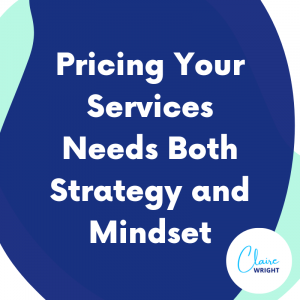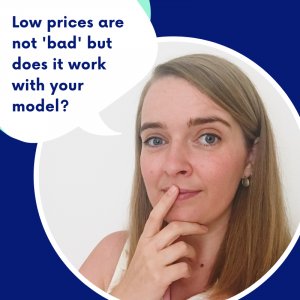There is almost no way to avoid dealing with pricing if you are in business (short of allowing clients to just pay what they want). There is no magic formula to pricing a service (nor for pricing a product really). No fixed hourly rate and no one telling us an amount we get to take home each month. And as a sole trader, selling yourself is often confronting. And it’s an aspect where we need to tackle both practical pricing strategies and mindset.
Financial success and pricing depend on your business model. Just like $10k months might not be the answer to all your problems. Effectively setting your prices depends on the way you structure your business and your financial requirements. There isn’t one right answer and, much as we might like, we can’t outsource our pricing or solely base it on our competitors. It needs to be specific to us, our business and our clients.
There are both pricing strategies and mindset aspects I think business owners should be aware of when it comes to putting a price tag on their services.
Business Model
Your pricing is hugely impacted by your business model so let’s explore some of the factors.
- The number of people in a session. Working one to one with a client clearly needs to cost more than if there are multiple people in a group setting. To earn $1200 for 10 hours of one to one work you need to charge $120 an hour. To earn $1200 for 3 hours of group work with 16 people you need to charge $75 each.
- How long are your clients’ sessions: 30 minutes, 90 minutes and 4 hours clearly need different prices. What’s interesting is that a single 4-hour session can be perceived as different in value to 4 x 60-minute sessions. But it depends on your client. Some will think finding 4 hours in one day is impossible and want to spend the work. Others will value getting the work done quickly rather than over four weeks. Your pricing needs to reflect what is important to your clients and what they perceive as valuable.
- If your business is built on retention and renewals versus client turnover clients where you need to consistently attract new clients will impact your pricing. If you need to attract new clients it’s more likely there will be gaps between clients and your pricing needs to reflect this.
Value
A thought that plagues me when it comes to valuing my work is that it’s easy and enjoyable for me. I love helping people with their finances, with their business, with their mindset. It comes naturally, they are my talents. I can overlook how special they are. There is a huge difference between the value you perceive and the value your client perceives. And it isn’t just what comes naturally, your experience and learnt skills are also hugely valuable to someone without that experience or those skills.
I could put together a pretty snazzy Excel workbook in a quite short space of time. But a client isn’t paying for my Vlookups and PivotTables and IF statements. They are paying for the outcome that the spreadsheet produces, an ability to quickly see how clients are tracking through their packages, without having to go through their calendar or booking system and count up the appointments.
To price effectively you need to think about the value your client gets from the service. Not the value of the process or hours together. But the value of the outcome. If you could choose to work with someone to achieve your goal in 2 hours or 10 hours which would you choose? If they both cost $1000 would it matter as long as you believed you could achieve the same outcome? One provider is charging $500 an hour, the other is charging $100 an hour. But the value of the outcome is the same. If your client doesn’t believe it can be achieved in 2 hours then they are unlikely to value it at that price point trade-off against hours.
Worth
I’m yet to come across a way to separate my self-worth from the value of my work. I’m a sole trader selling one to one work with clients. I know every time I sell a package that I’m the one delivering and I’ll be the one bringing home the profit as salary. I’m the person that needs to go out and advertise and promote my services. I need to talk to clients on sales calls and explain if and how I could help and add value to their businesses.
Setting a price that makes you feel uncomfortable isn’t always a recipe for growth. A little outside your comfort zone maybe, but way outside your comfort zone often results in discouraging your from actually promoting the service. Not believing people will pay that price is actually you thinking the outcome isn’t worth that price.
You need to work on growing your self-worth with your business, with your pricing. This confidence is built by delivering sessions, reviewing what works, learning from where things didn’t go well and checking clients are achieving the expected outcomes. It takes practice. There’s no shortcut. And working with and talking to clients will help you to understand the value they perceive and the transformations they achieve.
Pricing Strategies and Mindset
Low prices aren’t bad in themselves. Premium pricing isn’t 100% good either. Instead what we need to achieve is a price we are comfortable with so we promote and deliver with confidence. A pricing strategy that suits our business model and financial requirements. And a price where clients perceive the equivalent in value from the outcomes.
If you need my help working through your worth and values issues as a business owner reach out for a free chat.
Watch the Video
Pin for Later


